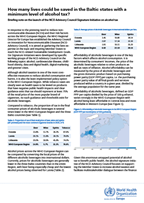Raising taxes on alcohol to save lives and protect public health
WHO is promoting alcohol taxation to address the burden of alcohol consumption in the WHO European Region, thereby saving lives and protecting public health.
Alcohol consumption: one of leading risk factors in the Region
Alcohol consumption remains one of the leading risk factors for death and disability in the WHO European Region, responsible for nearly 800 000 deaths every year. The harms are wide-ranging, from cancers, liver and cardiovascular diseases to injuries, violence and infectious diseases.
Raising the price of alcohol through taxation is one of WHO’s best buys, which are evidence-based, cost–effective interventions that reduce the burden of noncommunicable diseases (NCDs). It has more recently been identified as an NCD quick buy – a proven, cost–effective measure capable of delivering public health impact within 5 years, with alcohol taxation shown to produce measurable results in less than a year.
A win–win for health and government revenue
Alcohol taxation benefits both public health and public budgets. By making alcohol less affordable, higher taxes reduce consumption and related health harms, while also lowering broader economic costs such as productivity losses, social service expenditures and justice system costs.
Evidence shows that when taxes form a larger share of the final retail price of alcohol, governments consistently collect more revenue – even when people drink less; for example, a 10% increase in the tax share of alcoholic beverages was linked to an average of €59 per capita in additional revenue. These funds can then be earmarked and used to support health programmes and social services.
Alcohol taxation: current status and recommendations
Despite strong evidence, alcohol taxation remains underused in the WHO European Region. On average, excise taxes make up only 21% of the price of alcoholic beverages and 37% of total tax, with wide variation by beverage type. As of 2022, many countries had zero or low tax on wine, and excise taxes overall remain too low to curb harms. In contrast, WHO recommends tobacco excise taxes at 70% or more of the retail price, or 75% from all taxes combined.
Because incomes have risen faster than alcohol taxes, alcohol is often more affordable today than 20 years ago. A minimum tax share of at least 15% of the retail price per unit of alcohol, regardless of beverage type, could save more than 130 000 lives annually in the Region, with stronger taxation policies saving even more.
WHO-led initiatives to advance alcohol taxation
WHO works with countries to strengthen alcohol taxation as a core public health measure. This includes:
- evidence and tools – WHO produces regional reports, guidance and practical tools to support ministries of health and finance in designing effective alcohol tax policies;
- national reforms – WHO helps countries to optimize their taxation systems, linking excise taxes to alcohol content, adjusting for inflation and applying them consistently across beverages;
- global and regional initiatives – Through the “3 by 35” initiative, WHO urges countries to raise prices of tobacco, alcohol and sugary drinks by at least 50% by 2035 via taxation; and
- political momentum – WHO supports expert networks and country engagement to counter industry opposition and increase public and political backing for effective pricing policies.
With support from WHO, growing numbers of countries across the Region – from Finland and Lithuania to Estonia, the Russian Federation and other countries of the Commonwealth of Independent States – have raised alcohol taxes, showing a clear recognition that taxation is a powerful tool to cut consumption and reduce harm.







